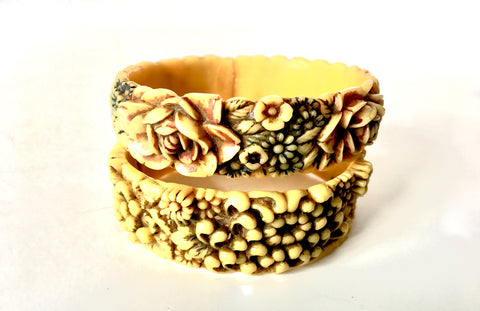talkingfashion » 1920
-
Celluloid, Bakelite, and Plastic: What Are They and How Are They Different?
Celluloid, Bakelite, and Plastic: What Are They and How Are They Different?
By Paige McKirahan
You walk into Barney’s New York with the intention of accessorizing for a night on the town and come to find bangles of all colors. They’re beautiful, light, and handmade. You wonder how normal plastic could look so elegant and check the tag, realizing it is made of vintage bakelite. What is this gorgeous material?
Celluloid and bakelite are vintage jewelry staples often mistaken for the normal plastics that are usually casted to make jewelry. These materials are among some of the first man made plastics on the market. Celluloid predates bakelite and was created in an attempt to win a contest calling for someone to create a substitute for ivory in the 1860s. Though it did not win the contest, its creator, John Hyatt, chose to begin a manufacturing company that used the plastic to create billiard balls. The problem, though, was that the material was flammable; it would create small explosions on billiard tables if the balls knocked together! It also constantly sparked fires in hot projection rooms on movie sets when used to create movie film. To identify this plastic, you don’t need to wait for it to accidentally catch fire; the easiest way is to rub the piece vigorously and smell it. If it is real celluloid, it should smell similar to a ping pong ball.
Now, when Bakelite emerged on onto the scene in 1909, it made a sort of different explosion. It became wildly more popular than celluloid because of the simple fact that it didn’t quite literally explode and was more lightweight. When it first came into circulation, it was used primarily for industrial purposes until it started becoming available in a variety of colors. This inexpensive material then became a huge favorite of jewelry makers and differs from regular plastic jewelry as it is hand carved or polished into its design. You can check to see if your bakelite isn’t an imposter by using the 409 test. You dip a cotton swab in 409, the common household cleaner, and touch a small area of the piece. Be sure to touch a part of the jewelry that will not be seen! If it is true Bakelite, it will leave a yellow stain on the cotton swab.
As a collector or simply a jewelry lover, it pays to know if you have a piece made with one of these materials as their value has only increased over the past few decades. Authentic pieces can sell for thousands of dollars and are coveted by many in the collecting community. So now that you know the what and how on celluloid and bakelite, we invite you to pull out your vintage pieces and start testing!
-
From Drab to Fab: The Functionality of Dress and Shoe Clips
From Drab to Fab: The Functionality of Dress and Shoe Clips
By Paige McKirahan
Have you ever wondered how you can change your boring, plain dresses and shoes into something spectacular? Something with character and pizazz? Well, the answer to that question of how lies in the 1930s with Hollywood icons and simple silhouettes.
By the ‘30s, dress and shoe clips were the “it” accessories; in the midst of the Great Depression, many women were looking for ways to emulate opulence and spice up plain clothing for cheap. This era paired with the imminent second World War forced fashion to become rationed, so these clips were an easy way for women to inexpensively adorn themselves to look similar to beloved movie stars like Marlene Dietrich, Tallulah Bankhead, Lana Turner, and Fay Wray. Dress clips were commonly worn as it is shown below, on the straps of a dress, or clipped as a symmetrical pair on square or sweetheart necklines.

Marlene Dietrich sporting a dress pin
(image credit to deviantart.com)
The popularity of the dress clip prompted the revitalization of the shoe clip, which originally came into circulation in the 18th century. The resurgence of the trend in the 1930s aimed to embellish plain pairs of flats or heels with some sparkle and flash, which differs vastly from the feathers and ruffles that were being clipped to shoes at the trend’s conception. Since the rise of hemlines began in the 1920s, these shoe clips were an easy way to accessorize an outfit from the ground up and could even be matched to dress clips to create a complete, cohesive look!
Though expensive jewelry makers were at the front of the line in creating these fun wearables, every costume jewelry maker from America to Europe had a line of clips in circulation. Eisenberg, Trifari, Coro, and Napier were rivaling Cartier and Van Cleer & Arpels in attempt to create a more affordable alternative to luxury pieces, catering to the economic climate of the era. Common materials used in these pieces were bakelite, faux gemstones, glass pearls, and other early plastics. These companies eventually stopped manufacturing this type of jewelry in the ‘50s and ‘60s, but they are still sought out by jewelry aficionados worldwide.

Coro Dress Clip Ad
(image credit to frenchgardenhouse.com)
Shoe and dress clips gave women the ability to sparkle literally from head to toe and that option is still available today. Charlize Theron and Sarah Jessica Parker took notes from old Hollywood starlets and sported dress clips on the red carpet at recent events. To spice up your look in a similar fashion, head over to our collection of brooches and pins so you too can start feeling that 1930s glam!




(image credits to everthingzoomer.com)













